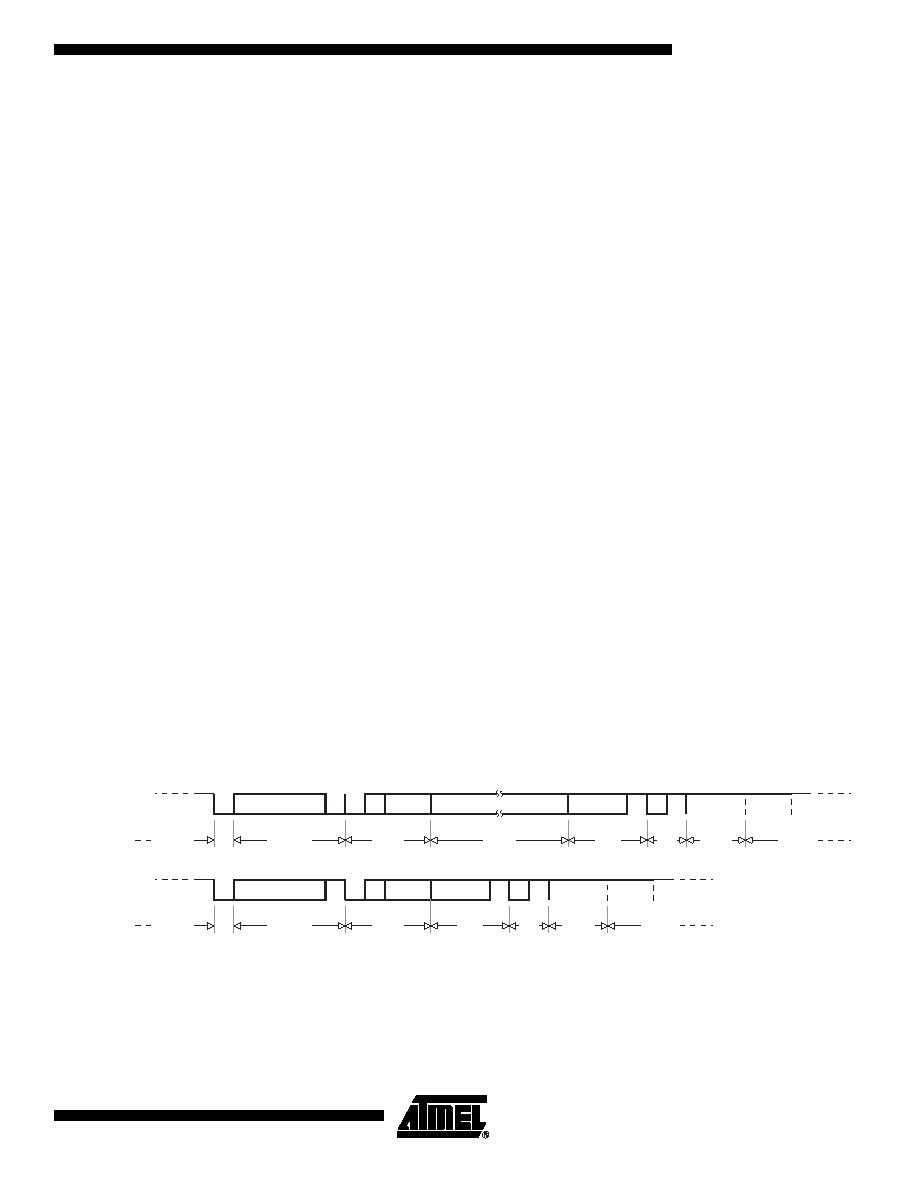参数资料
| 型号: | AT89C51CC03U-RDTIM |
| 厂商: | Atmel |
| 文件页数: | 183/198页 |
| 文件大小: | 0K |
| 描述: | IC 8051 MCU FLASH 64K 64VQFP |
| 标准包装: | 160 |
| 系列: | AT89C CAN |
| 核心处理器: | 8051 |
| 芯体尺寸: | 8-位 |
| 速度: | 40MHz |
| 连通性: | CAN,SPI,UART/USART |
| 外围设备: | POR,PWM,WDT |
| 输入/输出数: | 36 |
| 程序存储器容量: | 64KB(64K x 8) |
| 程序存储器类型: | 闪存 |
| EEPROM 大小: | 2K x 8 |
| RAM 容量: | 2.25K x 8 |
| 电压 - 电源 (Vcc/Vdd): | 3 V ~ 5.5 V |
| 数据转换器: | A/D 8x10b |
| 振荡器型: | 外部 |
| 工作温度: | -40°C ~ 85°C |
| 封装/外壳: | 44-LQFP |
| 包装: | 托盘 |
| 其它名称: | AT89C51CC03URDTIM |
第1页第2页第3页第4页第5页第6页第7页第8页第9页第10页第11页第12页第13页第14页第15页第16页第17页第18页第19页第20页第21页第22页第23页第24页第25页第26页第27页第28页第29页第30页第31页第32页第33页第34页第35页第36页第37页第38页第39页第40页第41页第42页第43页第44页第45页第46页第47页第48页第49页第50页第51页第52页第53页第54页第55页第56页第57页第58页第59页第60页第61页第62页第63页第64页第65页第66页第67页第68页第69页第70页第71页第72页第73页第74页第75页第76页第77页第78页第79页第80页第81页第82页第83页第84页第85页第86页第87页第88页第89页第90页第91页第92页第93页第94页第95页第96页第97页第98页第99页第100页第101页第102页第103页第104页第105页第106页第107页第108页第109页第110页第111页第112页第113页第114页第115页第116页第117页第118页第119页第120页第121页第122页第123页第124页第125页第126页第127页第128页第129页第130页第131页第132页第133页第134页第135页第136页第137页第138页第139页第140页第141页第142页第143页第144页第145页第146页第147页第148页第149页第150页第151页第152页第153页第154页第155页第156页第157页第158页第159页第160页第161页第162页第163页第164页第165页第166页第167页第168页第169页第170页第171页第172页第173页第174页第175页第176页第177页第178页第179页第180页第181页第182页当前第183页第184页第185页第186页第187页第188页第189页第190页第191页第192页第193页第194页第195页第196页第197页第198页

85
AT89C51CC03
4182O–CAN–09/08
CAN Controller
The CAN Controller provides all the features required to implement the serial communi-
cation protocol CAN as defined by BOSCH GmbH. The CAN specification as referred to
by ISO/11898 (2.0A and 2.0B) for high speed and ISO/11519-2 for low speed. The CAN
Controller is able to handle all types of frames (Data, Remote, Error and Overload) and
achieves a bitrate of 1-Mbit/sec at 8 MHz
1 Crystal frequency in X2 mode.
Note:
1. At BRP = 1 sampling point will be fixed.
CAN Protocol
The CAN protocol is an international standard defined in the ISO 11898 for high speed
and ISO 11519-2 for low speed.
Principles
CAN is based on a broadcast communication mechanism. This broadcast communica-
tion is achieved by using a message oriented transmission protocol. These messages
are identified by using a message identifier. Such a message identifier has to be unique
within the whole network and it defines not only the content but also the priority of the
message.
The priority at which a message is transmitted compared to another less urgent mes-
sage is specified by the identifier of each message. The priorities are laid down during
system design in the form of corresponding binary values and cannot be changed
dynamically. The identifier with the lowest binary number has the highest priority.
Bus access conflicts are resolved by bit-wise arbitration on the identifiers involved by
each node observing the bus level bit for bit. This happens in accordance with the "wired
and" mechanism, by which the dominant state overwrites the recessive state. The com-
petition for bus allocation is lost by all nodes with recessive transmission and dominant
observation. All the "losers" automatically become receivers of the message with the
highest priority and do not re-attempt transmission until the bus is available again.
Message Formats
The CAN protocol supports two message frame formats, the only essential difference
being in the length of the identifier. The CAN standard frame, also known as CAN 2.0 A,
supports a length of 11 bits for the identifier, and the CAN extended frame, also known
as CAN 2.0 B, supports a length of 29 bits for the identifier.
Can Standard Frame
Figure 43. CAN Standard Frames
A message in the CAN standard frame format begins with the "Start Of Frame (SOF)",
this is followed by the "Arbitration field" which consist of the identifier and the "Remote
Transmission Request (RTR)" bit used to distinguish between the data frame and the
data request frame called remote frame. The following "Control field" contains the "IDen-
tifier Extension (IDE)" bit and the "Data Length Code (DLC)" used to indicate the
11-bit identifier
ID10..0
Interframe
Space
4-bit DLC
DLC4..0
CRC
del.
ACK
del.
15-bit CRC
0 - 8 bytes
SOF
RTR IDE
r0
ACK
7 bits
Intermission
3 bits
Bus Idle
(Indefinite)
Arbitration
Field
Data
Field
Data Frame
Control
Field
End of
Frame
CRC
Field
ACK
Field
Interframe
Space
11-bit identifier
ID10..0
Interframe
Space
4-bit DLC
DLC4..0
CRC
del.
ACK
del.
15-bit CRC
SOF
RTR IDE
r0
ACK
7 bits
Intermission
3 bits
Bus Idle
(Indefinite)
Arbitration
Field
Remote Frame
Control
Field
End of
Frame
CRC
Field
ACK
Field
Interframe
Space
相关PDF资料 |
PDF描述 |
|---|---|
| AT89C51CC03U-7CTIM | IC 8051 MCU FLASH 64K 64BGA |
| AT89C51CC03C-S3SIM | IC 8051 MCU FLASH 64K 52PLCC |
| AT89C51CC03C-RLTIM | IC 8051 MCU FLASH 64K 44VQFP |
| AT89C51CC03C-7CTIM | IC 8051 MCU FLASH 64K 64BGA |
| AT89C5132-ROTIL | IC 8051 MCU FLASH 64K USB 80TQFP |
相关代理商/技术参数 |
参数描述 |
|---|---|
| AT89C51CC03U-RLRIM | 功能描述:IC 8051 MCU FLASH 64K 44VQFP RoHS:否 类别:集成电路 (IC) >> 嵌入式 - 微控制器, 系列:AT89C CAN 标准包装:1,500 系列:AVR® ATtiny 核心处理器:AVR 芯体尺寸:8-位 速度:16MHz 连通性:I²C,LIN,SPI,UART/USART,USI 外围设备:欠压检测/复位,POR,PWM,温度传感器,WDT 输入/输出数:16 程序存储器容量:8KB(4K x 16) 程序存储器类型:闪存 EEPROM 大小:512 x 8 RAM 容量:512 x 8 电压 - 电源 (Vcc/Vdd):2.7 V ~ 5.5 V 数据转换器:A/D 11x10b 振荡器型:内部 工作温度:-40°C ~ 125°C 封装/外壳:20-SOIC(0.295",7.50mm 宽) 包装:带卷 (TR) |
| AT89C51CC03U-RLTIM | 功能描述:IC 8051 MCU FLASH 64K 44VQFP RoHS:否 类别:集成电路 (IC) >> 嵌入式 - 微控制器, 系列:AT89C CAN 标准包装:9 系列:87C 核心处理器:8051 芯体尺寸:8-位 速度:40/20MHz 连通性:UART/USART 外围设备:POR,WDT 输入/输出数:32 程序存储器容量:32KB(32K x 8) 程序存储器类型:OTP EEPROM 大小:- RAM 容量:256 x 8 电压 - 电源 (Vcc/Vdd):4.5 V ~ 5.5 V 数据转换器:- 振荡器型:内部 工作温度:0°C ~ 70°C 封装/外壳:40-DIP(0.600",15.24mm) 包装:管件 |
| AT89C51CC03U-S3RIM | 功能描述:IC 8051 MCU FLASH 64K 52PLCC RoHS:否 类别:集成电路 (IC) >> 嵌入式 - 微控制器, 系列:AT89C CAN 标准包装:1,500 系列:AVR® ATtiny 核心处理器:AVR 芯体尺寸:8-位 速度:16MHz 连通性:I²C,LIN,SPI,UART/USART,USI 外围设备:欠压检测/复位,POR,PWM,温度传感器,WDT 输入/输出数:16 程序存储器容量:8KB(4K x 16) 程序存储器类型:闪存 EEPROM 大小:512 x 8 RAM 容量:512 x 8 电压 - 电源 (Vcc/Vdd):2.7 V ~ 5.5 V 数据转换器:A/D 11x10b 振荡器型:内部 工作温度:-40°C ~ 125°C 封装/外壳:20-SOIC(0.295",7.50mm 宽) 包装:带卷 (TR) |
| AT89C51CC03U-S3SIM | 制造商:Atmel Corporation 功能描述:MCU 8-bit AT89 80C51 CISC 64KB Flash 5V 52-Pin PLCC Stick |
| AT89C51CC03U-SLRIM | 功能描述:IC 8051 MCU FLASH 64K 44PLCC RoHS:否 类别:集成电路 (IC) >> 嵌入式 - 微控制器, 系列:AT89C CAN 标准包装:1,500 系列:AVR® ATtiny 核心处理器:AVR 芯体尺寸:8-位 速度:16MHz 连通性:I²C,LIN,SPI,UART/USART,USI 外围设备:欠压检测/复位,POR,PWM,温度传感器,WDT 输入/输出数:16 程序存储器容量:8KB(4K x 16) 程序存储器类型:闪存 EEPROM 大小:512 x 8 RAM 容量:512 x 8 电压 - 电源 (Vcc/Vdd):2.7 V ~ 5.5 V 数据转换器:A/D 11x10b 振荡器型:内部 工作温度:-40°C ~ 125°C 封装/外壳:20-SOIC(0.295",7.50mm 宽) 包装:带卷 (TR) |
发布紧急采购,3分钟左右您将得到回复。